Lecture 16: NS II
0.0(0)
Card Sorting
1/140
Earn XP
Description and Tags
Study Analytics
Name | Mastery | Learn | Test | Matching | Spaced |
|---|
No study sessions yet.
141 Terms
1
New cards
4 main functions of spinal cord
1. conduction
2. neural integration
3. locomotion
4. reflexes
2. neural integration
3. locomotion
4. reflexes
2
New cards
4 main functions of spinal cord - conduction
nerve fibers conduct sensory and motor information up and down the spinal cord
3
New cards
4 main functions of spinal cord - neural integration
ex: it can integrate the stretch sensation from a full bladder with cerebral input concerning the appropriate time and place to urinate and execute control of the bladder accordingly
4
New cards
4 main functions of spinal cord - locomotion
simple repetitive muscle contractions coordinated by groups of neurons (central pattern generators; AKA CPGs)
ex: put 1 foot in front of the other repeatedly while walking
ex: put 1 foot in front of the other repeatedly while walking
5
New cards
what are CPGs?
CPG are circuits of interneurons present within different spinal cord segments. When activated, they produce the patterns of neural activity that underlie rhythmic motor behaviors such as walking, breathing, flying and swimming
6
New cards
4 main functions of spinal cord - reflexes
involuntary responses to stimuli that are vital to posture, motor coordination and protective responses to pain or injury
7
New cards
cervical enlargement
beginning of the spinal cord; origin for nerves of upper limbs
8
New cards
lumbosacral enlargement
origin for nerves of pelvis and lower limbs
9
New cards
conus medullaris
where the spinal cord ends
10
New cards
cauda equina
bundle of spinal nerves in vertebral canal; innervates pelvis and lower limbs; latin for horse's tail
11
New cards
filum terminale
portion of the pia mater that supports the cauda equina
12
New cards
How many layers of membrane protect the brain and spinal cord?
3
13
New cards
T or F: There is an anterior root ganglion
False; there is no anterior root ganglion (somas of these neurons are in the gray matter of the spinal cord)
14
New cards
Cross-section of spinal cord
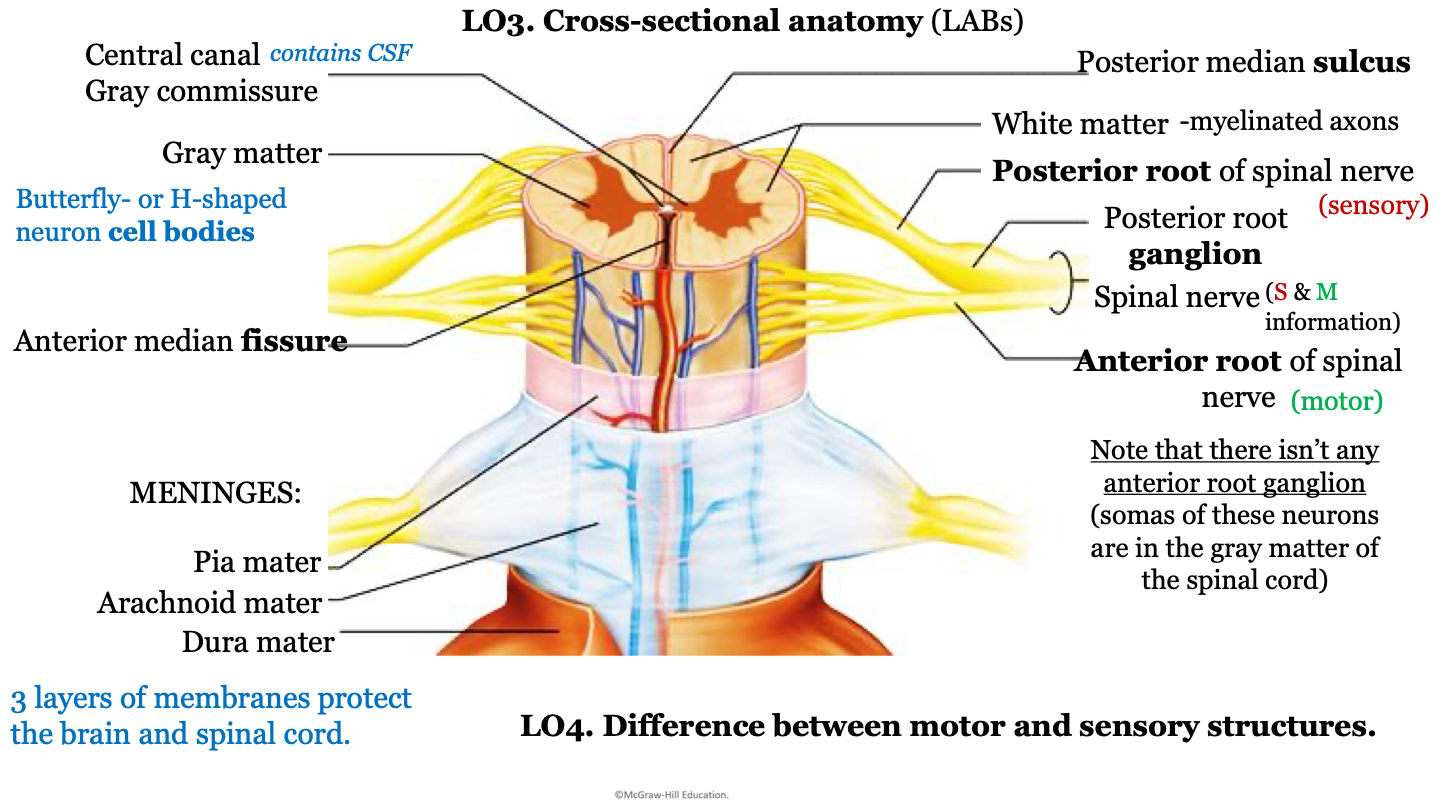
15
New cards
Why is white matter white?
because it contains lipids
16
New cards
Gray matter
butterfly or H-shaped neuron cell bodies; regions of gray matter also have farious groups of neuron cell bodies called nuclei; subdivided into regions called horns: posterior gray horn, lateral gray horn, and anterior gray horn.
17
New cards
white matter
composed primarily of myelinated axons (organized in tracts); divided into 3 columns (funiculi): posterior white column, lateral white column, and anterior white column
18
New cards
lateral gray horn
Only through T1-L2. It contains the cell bodies of autonomic motor neurons which innervate cardiac muscle, smooth muscle, and glands - sympathetic NS),
19
New cards
T or F: Sensory information enters the spinal cord via the ventral roots of the spinal nerves
False; sensory information enters through the dorsal roots
20
New cards
Where are the cell bodies of sensory neurons located?
in the ganglion
21
New cards
Where are the cell bodies of motor neurons located?
in the horns of the spinal cord
22
New cards
What kind of information does the ventral root carry?
motor/efferent
23
New cards
What does SS indicate?
Interneurons receiving input from somatic sensory neurons; found in dorsal horn
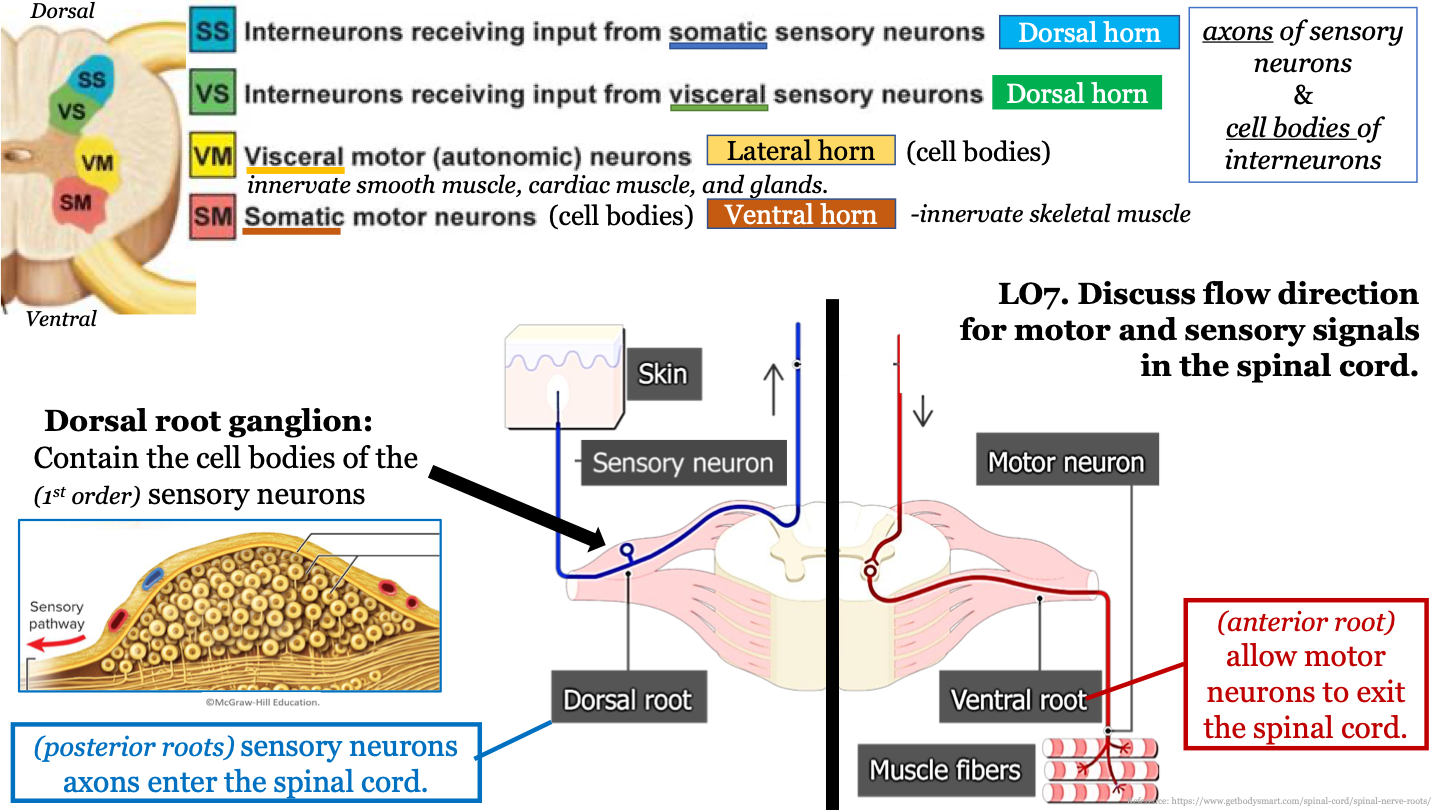
24
New cards
What does VS indicate?
Interneurons receiving input from visceral sensory neurons; found in dorsal horn
25
New cards
What does VM indicate?
Visceral motor (autonomic) neurons (cell bodies) that innervate smooth muscle, cardiac muscle, and glands; found in lateral horn
26
New cards
What does SM indicate?
Somatic motor neurons (cell bodies) that innervate skeletal muscle; found in ventral horn
27
New cards
Do axons or cell bodies correspond to sensory neurons?
axons
28
New cards
Do axons or cell bodies correspond to interneurons?
cell bodies
29
New cards
dorsal root ganglion
contain the cell bodies of the (1st order) sensory neurons
30
New cards
How do sensory neuron axons enter the spinal cord?
through the posterior roots
31
New cards
How do motor neurons exit the spinal cord?
through the anterior roots
32
New cards
What kind of information uses the ascending tract?
Sensory information
33
New cards
What kind of information uses the descending tract?
Motor information
34
New cards
tract
bundles of CNS axons that share a common origin, destination, and function
35
New cards
what are ascending tracts also known as?
somatosensory pathways or systems
36
New cards
What are the three primary types of ascending pathways on each side of the spinal cord?
1. Spinothalamic (or anterolateral) pathway
2. Spinocerebellar pathway
3. Dorsal column-medial lemniscus pathway
2. Spinocerebellar pathway
3. Dorsal column-medial lemniscus pathway
37
New cards
ipsilateral
when the origin and destination of a tract are on the same side of the body
38
New cards
decussation
point at which some tracts cross over from left side of the body to the right or vice versa
39
New cards
contralateral
on opposite sides of the body
40
New cards
neurites
small processes on developing neurons that ultimately grow out into axons or dendrites
41
New cards
How many tracts make up the Spinothalamic (or anterolateral) pathway? What are they?
2 separate tracts; lateral and anterior; these fibers cross over (decussate) within the spinal cord; although the tracts are functionally distinct, these tracts run alongside each other, and they can be considered a single pathway
42
New cards
What order neurons make up the Spinothalamic (or anterolateral) pathway?
1st, 2nd, and 3rd order; 1st order neurons come from periphery (ex: skin), go through dorsal neurons to the interneuron in the vertebra; the info is passed to 2nd order neurons here; moves up the axons to the thalamus where we have 3rd order neurons; these pass info to the cortex
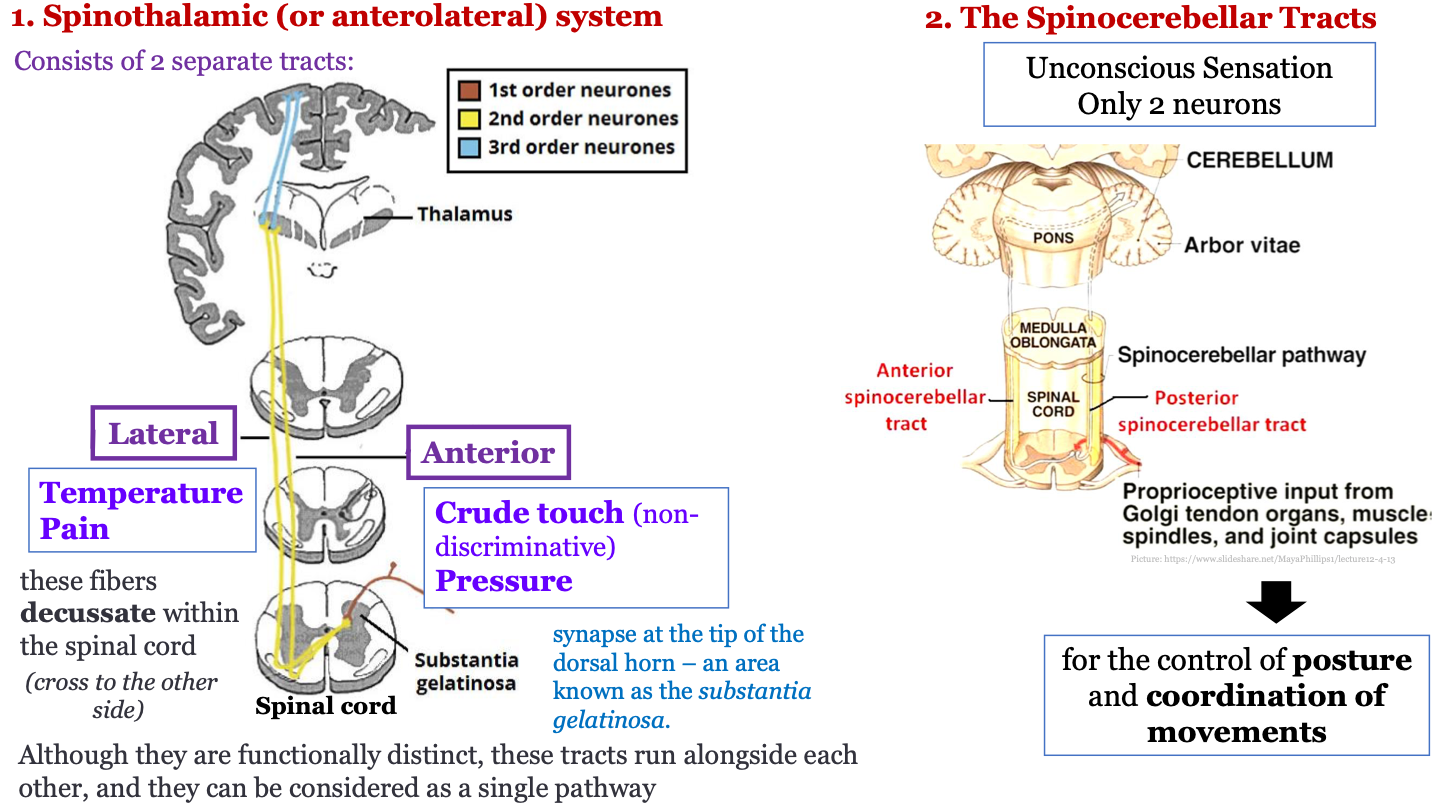
43
New cards
sebstantia gelatinosa
synapse between 1st and 2nd order neurons at the tip of the dorsal horn
44
New cards
What type of information does the lateral tract of the Spinothalamic (or anterolateral) pathway detect?
Temperature and pain
45
New cards
What type of information does the anterior tract of the Spinothalamic (or anterolateral) pathway detect?
crude touch (non-discriminative) and pressure
46
New cards
If information reaches the cortex is it conscious or unconscious?
conscious
47
New cards
Does the spinocerebellar tract deal with conscious or unconscious sensation?
unconscious senesation
48
New cards
How many neurons make up the spinocerebellar tract?
2 neurons; anterior and posterior spinocerebellar tracts
49
New cards
What kind of information does the spinocerebellar tract recieve? Why is this important?
Proprioceptive information from golgi tendon organs, muscle spindles and joint capsules; for the control of posture and coordination of movements
50
New cards
Where do the third order neurons have their cell body in the anterolateral system?
A) Cortex
B) Thalamus
C) Medulla
D) Spinal cord
A) Cortex
B) Thalamus
C) Medulla
D) Spinal cord
B) Thalamus
51
New cards
The cell bodies found in the posterior gray horns of the substantia gelatinosa belongs to:
A) 1st order sensory neurons
B) 2nd order sensory neurons
C) 3rd order sensory neurons
D) 1st order motor neurons
A) 1st order sensory neurons
B) 2nd order sensory neurons
C) 3rd order sensory neurons
D) 1st order motor neurons
B) 2nd order sensory neurons because their fibers form the ascending tracts. They carry sensory impulses to the thalamus
52
New cards
Which of the sensory modalities (sensory information) is NOT carried by the spinothalamic system?
A) Pain
B) Pressure
C) Crude touch
D) Proprioception
A) Pain
B) Pressure
C) Crude touch
D) Proprioception
D) Proprioception because the spinothalamic tract conveys pain, temperature, and crude touch; the spinocerebellar tract carries proprioception.
53
New cards
What sensory modalities does the dorsal column-medial pathway (DCML) carry?
-fine (discriminative) touch
-proprioception (movement and joint position)
*Conscious sensations
-proprioception (movement and joint position)
*Conscious sensations
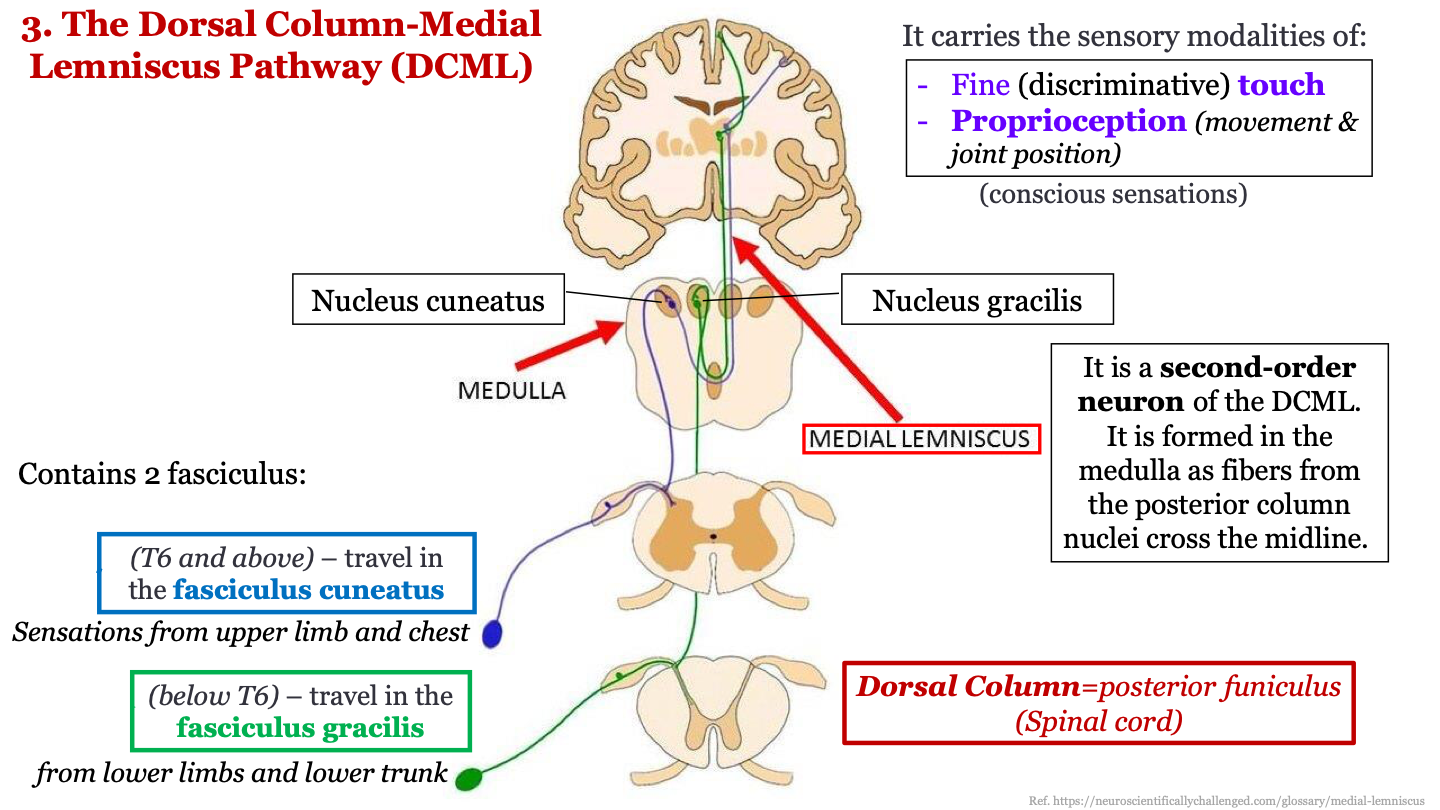
54
New cards
medial lemniscus
second order sensory neuron of the DCML; formed in the medulla as fibers from the posterior column nuclei cross the midline
55
New cards
dorsal column
posterior funiculus of spinal cord
56
New cards
How many fasciculi does the DCML contain?
2 fasciculus; fasciculus cuneatus and fasciculus gracilis

57
New cards
What sensations does the fasciculus cutaneous of the DCML detect?
sensations from upper limb and chest; T6 and above
58
New cards
What sensations does the fasciculus gracilis of the DCML detect?
sensations from lower limbs and lower trunk; below T6
59
New cards
nucleus cuneatus
where the 2 fasciculus synapse with other neurons
60
New cards
What are the two major groups of descending motor tracts in the spinal cord?
pyramidal tracts and extrapyramidal tracts (EPTs)
61
New cards
Where do pyramidal tracts originate?
cerebral motor cortex
62
New cards
Where do extrapyramidal tracts originate?
brain stem
63
New cards
What is the cerebral motor cortex responsible for?
voluntary (conscious) control of the musculature
64
New cards
What two tracts does the cerebral motor cortex control?
corticobulbar tract (musculature of the head and neck) and the corticospinal tract (musculature of the limbs and trunk)
65
New cards
How do pyramidal tracts innervate neurons?
They directly innervate neurons in the ventral horn
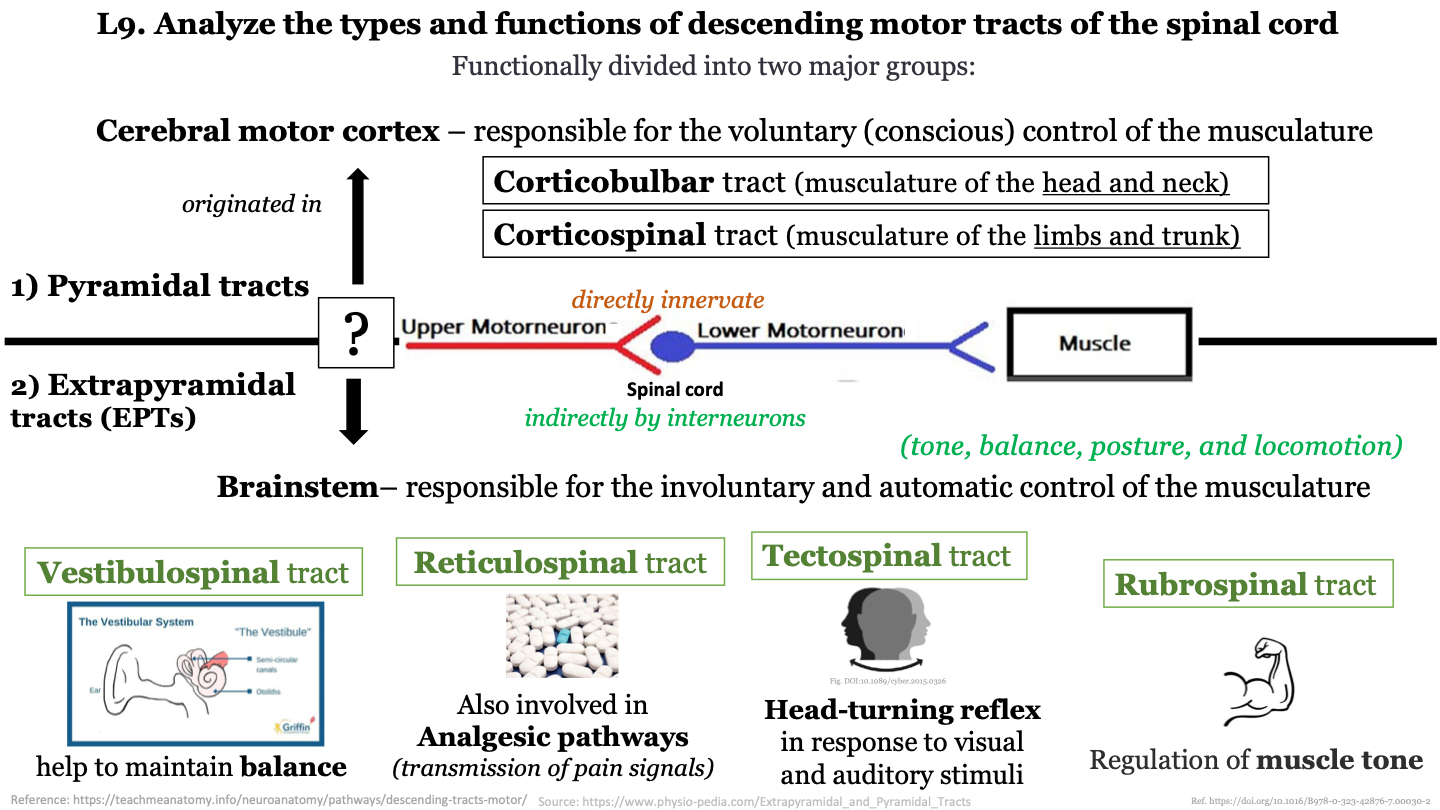
66
New cards
How do extrapyramidal tracts (EPTs) innervate neurons?
They indirectly innervate interneurons that will either activate or inhibit the lower motor neurons; the cerebral cortex of the brain sends signals to the spinal cord and then this info is carried from the spinal cord to the muscle
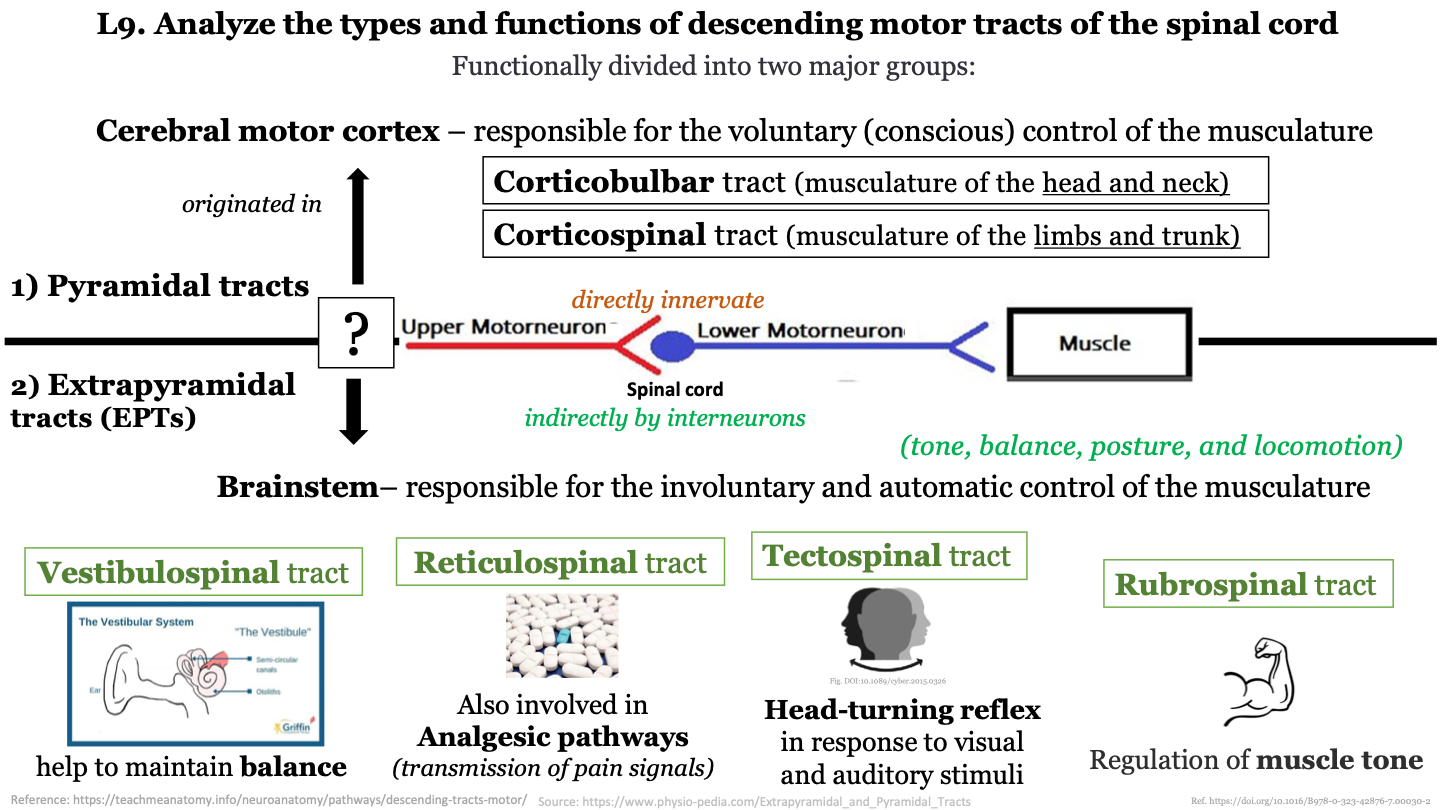
67
New cards
What is the importance of the Extrapyramidal tract?
Aids in tone, balance, posture, and locomotion
68
New cards
What is the brainstem responsible for?
the involuntary movement and autonomic control of musculature (unconscious)
69
New cards
extrapyramidal tracts - vestibulospinal tract
helps to maintain balance
70
New cards
extrapyramidal tracts - reticulospinal tract
involved in analgesic pathways (transmission of pain signals)
71
New cards
extrapyramidal tracts - Tectospinal tract
produces head-turning reflex in response to auditory and visual stimuli
72
New cards
extrapyramidal tracts - rubrospinal tract
regulation of muscle tone
73
New cards
medullary pyramids
paired white matter structures of the brainstem's medulla oblongata that contain motor fibers of the corticospinal and corticobulbar tracts
74
New cards
what does the corticospinal pathway control?
contralateral muscles
75
New cards
how many motor neurons are involved in the corticospinal tract?
2 motor neurons (upper and lower)
76
New cards
where does the upper motor neuron of the corticospinal pathway originate/end?
Starts in the motor cortex and runs down spinal cord
77
New cards
where does the lower motor neuron of the corticospinal pathway originate/end?
neurosoma is in the brainstem/spinal cord and its axon leads to a muscle/target organ
78
New cards
what two tracts make up the corticospinal pathway?
lateral corticospinal tract and anterior corticospinal tract
79
New cards
do fibers of the lateral corticospinal tract stay on one side of the body or cross over? What % of fibers are in the lateral corticospinal tract?
fibers cross over the pyramids to other side of the body; 90% of fibers in corticospinal pathway are lateral.

80
New cards
do fibers of the anterior corticospinal tract stay on one side of the body or cross over? What % of fibers are in the lateral corticospinal tract?
fibers stay on one side; 10% of fibers in the corticospinal pathway are anterior

81
New cards
How do spinal nerves communicate with the brain?
via the spinal cord
82
New cards
how many pairs of spinal nerves are there? Are they mixed? What do they innervate?
31 pairs; yes; trunk and limbs
83
New cards
how many pairs of cranial nerves are there? Are they mixed? What do they innervate?
12 pairs of cranial nerves; some are snesory or motor but most are mixed; they innervate the head and neck and the vagus nerve (internal organs); these originate from the bade of the brain
84
New cards
what are the two major groups of nerves?
spinal and cranial nerves
85
New cards
what two nerve roots fuse together to form a spinal nerve?
dorsal and ventral nerve roots
86
New cards
epinerium
covers the entire peripheral nerve
87
New cards
perineurium
the sheath of connective tissue that covers a bundle of nerve fibers (fascicles)
88
New cards
endoneurium
delicate connective tissue around individual nerve fibers in nerve
89
New cards
what is each fascicle in a nerve composed of?
motor, sensory, and sympathetic fibers
90
New cards
what does a typical nerve consist of
several axon bundles (fascicles)
91
New cards
mixed nerve
spinal nerve; nerve containing both sensory and motor fibers
92
New cards
What kind of axons are in the posterior root?
sensory axons only; cell bodies of sensory neurons are located in posterior root ganglion
93
New cards
What kind of axons are in the anterior root?
motor axons only; multiple anterior rootlets arise from the spinal cord and merge to form a single anterior root
94
New cards
Where are the cervical nerves of the spine?
Top of the spine; C1-C8
95
New cards
Where are the thoracic nerves of the spine?
Under the cervical nerves and above the lumbar nerves; T1-T12
96
New cards
Where are the lumbar nerves of the spine?
Above the sacral nerves and under thoracic nerves; L1-L5
97
New cards
Where are the sacral nerves of the spine?
Bottom of the spine; S1-S5
98
New cards
What is the relationship between each segmental region of the spinal cord and its function?
Each segmental region of the spinal cord innervates a specific region of the skin, muscle, or organ group
99
New cards
What are the effects of damage to the spinal cord?
partial or complete loss of function below the level of injury
100
New cards
dermatome map
diagram of the cutaneous regions innervated by each spinal nerve (areas of sensation)